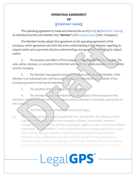What to Do When an Employee Requests to See Their Personnel File
You’re managing your small bakery when an employee emails, demanding to see their personnel file by next week. You’re unsure what’s required, what...
8 min read
LegalGPS : May. 16, 2025
Taking the leap from solopreneur to employer is one of the most significant milestones in your business journey. Hiring your first employee doesn't just mean adding headcount—it represents a fundamental shift in how your business operates and signals confidence in your growth trajectory.


Legal GPS Pro
Protect your business with our complete legal subscription service, designed by top startup attorneys.
While bringing on your first team member is exciting, it also comes with a maze of legal requirements, financial considerations, and management responsibilities that you haven't had to navigate before. This comprehensive guide will walk you through everything you need to know to make this transition as smooth and successful as possible.
Before posting that job listing, you need to ensure your business is truly ready for an employee. This preparation phase is crucial for setting both you and your future hire up for success.
Ask yourself these critical questions:
If you answered "yes" to most of these questions, it's likely time to consider hiring.
The true cost of an employee extends far beyond their salary. You'll need to budget for:
As a rule of thumb, expect the total cost to be approximately 1.25-1.4 times the employee's salary.
Before hiring, you'll need to:
Taking care of these fundamentals before you begin interviewing will prevent scrambling later and demonstrate professionalism to your candidate.

Employment Agreement
Craft a solid Employment Agreement with this guide covering essential terms protections and best practices for employers.
Trusted by 1,000+ businesses to safeguard their LLCs.
Finding the right first employee is critical—this person will help shape your company culture and may eventually become a leader as you grow.
Consider these channels for your search:
The best candidates often come through referrals, so don't hesitate to let your network know you're hiring.
Your job posting should clearly communicate:
Be honest about the realities of working in a small business. The right candidate will be excited about wearing multiple hats and growing with your company.
For your first employee, consider a multi-stage interview process:
Throughout this process, assess not just their skills but also their fit with your working style and company vision.
A well-crafted job description is your first filter for finding the right candidate. Here's how to create one that attracts top talent:
Remember, your job description is often a candidate's first impression of your company—make it count!
Hiring an employee comes with significant legal and administrative responsibilities. Here's what you need to know:
For each new hire, you must:
One critical decision is whether to classify your hire as:
This classification has significant legal implications. Misclassifying employees as contractors can result in substantial penalties, so consult with a tax professional if you're unsure.
You'll need a system to:
Many small businesses use payroll services like Gusto, QuickBooks Payroll, or ADP to handle these requirements.


Legal GPS Pro
Protect your business with our complete legal subscription service, designed by top startup attorneys.
Even with just one employee, you must comply with:
Here's a real-world timeline showing how a small marketing agency prepared to hire their first employee:
By preparing methodically, they turned what could have been an overwhelming process into a manageable checklist that ensured full compliance.
A thoughtful onboarding process sets the tone for your working relationship and helps your new hire become productive quickly.
Develop a structured plan covering:
Document this plan so you can refine it for future hires.
Make your employee's first day special and productive:
For many small businesses, training is hands-on and personalized:
Be patient and remember that proper training is an investment that pays off through greater productivity and fewer mistakes.
From day one, ensure your employee understands:
Even with just one employee, an employee handbook is invaluable for setting expectations and protecting your business legally. Here's how to create one that works for a small business:
Remember, a good handbook protects both you and your employee by establishing clear guidelines and expectations from the start.
When you hire your first employee, you're no longer just running a business—you're creating a workplace culture.
Take time to articulate:
Involve your employee in refining these values so they feel invested in your company's mission.

Employment Agreement
Craft a solid Employment Agreement with this guide covering essential terms protections and best practices for employers.
Trusted by 1,000+ businesses to safeguard their LLCs.
Establish regular opportunities for two-way feedback:
Remember that as a first-time employer, you should be seeking feedback on your management style as well.
Transitioning from solopreneur to boss requires:
This balance takes practice—be patient with yourself as you develop your management style.
Here's how a small e-commerce business structured the first 90 days for their first employee, a customer service and operations assistant:
This structured approach gave the employee clear expectations while allowing flexibility to adapt as they discovered their strengths and interests within the business.
Hiring your first employee represents a pivotal moment in your business journey. While the process involves numerous legal, financial, and management considerations, proper preparation can transform this challenge into an opportunity for significant growth.
Remember these key principles as you move forward:
With thoughtful planning and the right first hire, you're not just adding help—you're building the foundation for your company's future.
The biggest question now is, "Do you need a lawyer for your business?” For most businesses and in most cases, you don't need a lawyer to start your business. Instead, many business owners rely on Legal GPS Pro to help with legal issues.
Legal GPS Pro is your All-In-One Legal Toolkit for Businesses. Developed by top startup attorneys, Pro gives you access to 100+ expertly crafted templates including operating agreements, NDAs, and service agreements, and an interactive platform. All designed to protect your company and set it up for lasting success.

Legal GPS Pro
Protect your business with our complete legal subscription service, designed by top startup attorneys.
|
Premium Template
Single-use Template |
Legal GPS Pro
Unlimited Access, Best Value |
|
|
| Choose Template | Learn More |
| Trusted by 1000+ businesses | |

You’re managing your small bakery when an employee emails, demanding to see their personnel file by next week. You’re unsure what’s required, what...

You’re scrolling through LinkedIn when you spot a post: your top salesperson, still on your payroll, is boasting about their new role at a rival...

In today's dynamic business landscape, companies of all sizes are increasingly turning to freelancers to fulfill specific project needs, access...